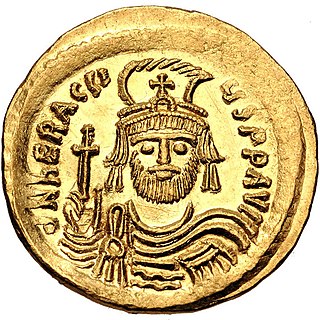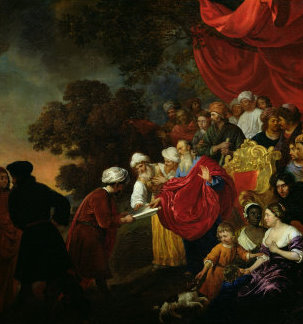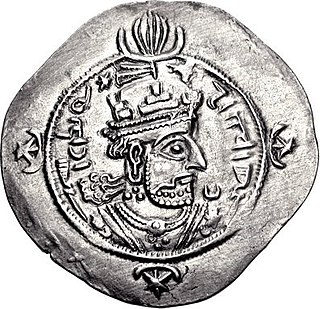Related Research Articles

Heraclius was Byzantine emperor from 610 to 641. His rise to power began in 608, when he and his father, Heraclius the Elder, the Exarch of Africa, led a revolt against the unpopular emperor Phocas.

According to the Biblical narrative, Zerubbabel was a governor of the Achaemenid Empire's province of Yehud and the grandson of Jeconiah, penultimate king of Judah. Zerubbabel led the first group of Jews, numbering 42,360, who returned from the Babylonian captivity in the first year of Cyrus the Great, the king of the Achaemenid Empire. The date is generally thought to have been between 538 and 520 BC. Zerubbabel also laid the foundation of the Second Temple in Jerusalem soon after.

Kavad II was the Sasanian King of Kings of Iran briefly in 628.

Khosrow II, commonly known as Khosrow Parviz, is considered to be the last great Sasanian king (shah) of Iran, ruling from 590 to 628, with an interruption of one year.

Shahrbaraz, was shah (king) of the Sasanian Empire from 27 April 630 to 9 June 630. He usurped the throne from Ardashir III, and was killed by Iranian nobles after forty days. Before usurping the Sasanian throne he was a spahbed (general) under Khosrow II (590–628). He is furthermore noted for his important role during the climactic Byzantine–Sasanian War of 602–628, and the events that followed afterwards.

The exilarch was the leader of the Jewish community in Persian Mesopotamia during the era of the Parthians, Sasanians and Abbasid Caliphate up until the Mongol invasion of Baghdad in 1258, with intermittent gaps due to ongoing political developments. The exilarch was regarded by the Jewish community as the royal heir of the House of David and held a place of prominence as both a rabbinical authority and as a noble within the Persian court.

The Davidic line or House of David is the lineage of the Israelite king David. In Judaism it is based on texts from the Hebrew Bible and through the succeeding centuries based on later traditions.
Bostanai, also transliterated as Bustenai or Bustnay, was the first Exilarch under Arab rule. He lived in the early-to-middle of the 7th century, and died about AD 660. The name is Aramaized from the Persian bustan or bostan, meaning "Garden". Bostanai is the only Dark Age Babylonian Exilarch of whom anything more than a footnote is known. He is frequently made the subject of Jewish legends.

Boran was Sasanian queen (banbishn) of Iran from 630 to 632, with an interruption of some months. She was the daughter of king Khosrow II and the Byzantine princess Maria. She is the second of only three women to rule in Iranian history, the others being Musa of Parthia, and Boran's sister Azarmidokht.
Armilus is an anti-messiah figure in medieval Jewish eschatology who will conquer the whole Earth, centralizing in Jerusalem and persecuting the Jewish believers until his final defeat at the hands of the Jewish Messiah. His believed destruction symbolizes the ultimate victory of the Jewish Messiah in the Messianic Age.

The Jewish revolt against Heraclius was part of the Byzantine–Sasanian War of 602–628 and is considered the last serious Jewish attempt to regain autonomy in Palaestina Prima prior to modern times.
In Jewish eschatology Mashiach ben Yoseph or Messiah ben Joseph, also known as Mashiach bar/ben Ephraim, is a Jewish messiah from the tribe of Ephraim and a descendant of Joseph. The figure's origins are much debated. Some regard it as a rabbinic invention, but others defend the view that its origins are in the Torah.

A number of midrashim exist which are smaller in size, and generally later in date, than those dealt with in the articles Midrash Haggadah and Midrash Halakah. Despite their late date, some of these works preserve material from the Apocrypha and Philo of Alexandria. These small works, were in turn used by later larger works, such as Sefer haYashar (midrash). Important editors and researchers of this material include Abraham ben Elijah of Vilna, Adolf Jellinek, and Solomon Aaron Wertheimer.

Sefer Zerubavel, also called the Book of Zerubbabel or the Apocalypse of Zerubbabel, is a medieval Hebrew-language apocalypse written at the beginning of the seventh century CE in the style of biblical visions placed into the mouth of Zerubbabel, the last descendant of the Davidic line to take a prominent part in Israel's history, who laid the foundation of the Second Temple in the sixth century BCE. The enigmatic postexilic biblical leader receives a revelatory vision outlining personalities and events associated with the restoration of Israel, the End of Days, and the establishment of the Third Temple.

The Sasanian conquest of Jerusalem was a significant event in the Byzantine–Sasanian War of 602–628, having taken place in early 614. Amidst the conflict, Sasanian king Khosrow II had appointed Shahrbaraz, his spahbod, to lead an offensive into the Diocese of the East of the Byzantine Empire. Under Shahrbaraz, the Sasanian army had secured victories at Antioch as well as at Caesarea Maritima, the administrative capital of Palaestina Prima. By this time, the grand inner harbour had silted up and was useless, but the city continued to be an important maritime hub after Byzantine emperor Anastasius I Dicorus ordered the reconstruction of the outer harbour. Successfully capturing the city and the harbour had given the Sasanian Empire strategic access to the Mediterranean Sea. The Sasanians' advance was accompanied by the outbreak of a Jewish revolt against Heraclius; the Sasanian army was joined by Nehemiah ben Hushiel and Benjamin of Tiberias, who enlisted and armed Jews from across Galilee, including the cities of Tiberias and Nazareth. In total, between 20,000 and 26,000 Jewish rebels took part in the Sasanian assault on Jerusalem. By mid-614, the Jews and the Sasanians had captured the city, but sources vary on whether this occurred without resistance or after a siege and breaching of the wall with artillery.

The Byzantine–Sasanian War of 602–628 was the final and most devastating of the series of wars fought between the Byzantine Empire and the Persian Sasanian Empire. The previous war between the two powers had ended in 591 after Emperor Maurice helped the Sasanian king Khosrow II regain his throne. In 602 Maurice was murdered by his political rival Phocas. Khosrow declared war, ostensibly to avenge the death of the deposed emperor Maurice. This became a decades-long conflict, the longest war in the series, and was fought throughout the Middle East: in Egypt, the Levant, Mesopotamia, the Caucasus, Anatolia, Armenia, the Aegean Sea and before the walls of Constantinople itself.
Benjamin of Tiberias was a man of immense wealth, who enlisted and armed many soldiers during the Jewish revolt against Heraclius in the 7th century Palaestina province of the Byzantine Empire. The Persian force was joined by Benjamin of Tiberias, who enlisted and armed Jewish soldiers from Tiberias, Nazareth and the mountain cities of Galilee. Together they marched on Jerusalem. Later, they were joined by the Jews of the southern parts of the country; and supported by a band of Arabs, the united forces took Jerusalem in 614 CE. Benjamin was one of the leaders of the revolt, actively participating in the Persian siege and capture of Jerusalem in 614. It is thought that the second leader Nehemiah ben Hushiel was appointed as ruler of Jerusalem.
Menahem ben Ammiel, or ben Amiel, is a character in apocalyptic Jewish texts, the future Messiah ben David of the Sefer Zerubbabel. He fights against Armilus.
The siege of Caesarea relates to the siege and conquest of Caesarea Maritima of the Byzantine Empire's Palaestina Prima province by the Sasanian Empire in 614 CE.
Hephzibah or Hepzibah is a figure in the Apocalypse of Zerubbabel, who is also mentioned in the Zohar. She was the wife of Nathan, and the mother of Menahem ben Ammiel, a putative messiah.
References
- 1 2 3 Haim Hillel Ben-Sasson (1976). A History of the Jewish People . Harvard University Press. p. 362. ISBN 978-0-674-39730-9 . Retrieved 19 January 2014.
nehemiah ben hushiel.
- ↑ Edward Lipiński (2004). Itineraria Phoenicia. Peeters Publishers. pp. 542–543. ISBN 978-90-429-1344-8 . Retrieved 11 March 2014.
- ↑ Jacob Neusner (1970). A history of the Jews in Babylonia v. later Sasanian times. printed in the Netherlands. p. 126. Retrieved 15 January 2014.
- 1 2 3 Jacob Neusner (1970). A history of the Jews in Babylonia v. later Sasanian times. printed in the Netherlands. p. 127. Retrieved 15 January 2014.
- ↑ Meir Holder (1986). History of the Jewish People: From Yavneh to Pumbedita. printed in the Netherlands. pp. 265–266. ISBN 978-0-89906-499-4 . Retrieved 19 January 2014.
- ↑ Frank Meir Loewenberg (January 2012). "A Forgotten Chapter Of Jewish History: The Persian Conquest Of Jerusalem". jewishmag.com. Retrieved 2014-06-09.
- ↑ Kaufmann Kohler; A. Rhine (1906). CHOSROES (KHOSRU) II. PARWIZ ("The Conqueror"). Jewish Encyclopedia. Retrieved 20 January 2014.
- 1 2 3 Robert W. Thomson; James Howard-Johnston; Tim Greenwood (1999). The Armenian History Attributed to Sebeos. Liverpool University Press. p. 207. ISBN 978-0-85323-564-4 . Retrieved 17 January 2014.
- 1 2 Robert W. Thomson; James Howard-Johnston; Tim Greenwood (1999). The Armenian History Attributed to Sebeos. Liverpool University Press. pp. 69–71. ISBN 978-0-85323-564-4 . Retrieved 17 January 2014.
- ↑ Robert W. Thomson; James Howard-Johnston; Tim Greenwood (1999). The Armenian History Attributed to Sebeos. Liverpool University Press. p. 208. ISBN 978-0-85323-564-4 . Retrieved 17 January 2014.
- ↑ Robert W. Thomson; James Howard-Johnston; Tim Greenwood (1999). The Armenian History Attributed to Sebeos. Liverpool University Press. p. 209. ISBN 978-0-85323-564-4 . Retrieved 17 January 2014.
- ↑ Silver, Abba Hillel (2003). "II The Mohammedan Period". History of Messianic Speculation in Israel. Kessinger Publishing. p. 49. ISBN 0-7661-3514-4.
- 1 2 "Sefer Zerubbabel". Translated by John C. Reeves. University of North Carolina at Charlotte. 24 April 2013. Retrieved 2014-01-17.
- 1 2 Jewish Martyrs in the Pagan and Christian Worlds. Cambridge university press. Cambridge , New York, Melbourne, Madrid, Cape Town, Singapore, Sao Paulo. 2006. pp. 108–109. ISBN 978-1-139-44602-0 . Retrieved 2014-01-10.
- 1 2 3 4 Günter Stemberger (2010). Judaica Minora: Geschichte und Literatur des rabbinischen Judentums. Mohr Siebeck. ISBN 978-3-16-150571-3 . Retrieved 17 December 2014.
- ↑ Alexei Sivertsev (2011). Judaism and Imperial Ideology in Late Antiquity. Cambridge University Press. p. 57. ISBN 978-1-107-00908-0 . Retrieved 17 December 2014.
- ↑ "'Otot ha-Mašiah (Signs of the Messiah)". Translated by John C. Reeves. University of North Carolina at Charlotte. 24 April 2013. Retrieved 2014-01-20.
- ↑ "Tefillat (Prayer of) R. Shimon b. Yohai". Translated by John C. Reeves. University of North Carolina at Charlotte. 24 April 2013. Retrieved 2014-01-22.
- ↑ "'Otot of R. Shimon b. Yohai". Translated by John C. Reeves. University of North Carolina at Charlotte. 24 April 2013. Retrieved 2014-01-22.
- ↑ "Ten Signs". Translated by John C. Reeves. University of North Carolina at Charlotte. 24 April 2013. Retrieved 2014-01-22.
- 1 2 John C. Reeves (2005). Trajectories in Near Eastern Apocalyptic: A Postrabbinic Jewish Apocalypse Reader. Society of Biblical Literature Atlanta. ISBN 978-1-58983-102-5 . Retrieved 31 January 2014.
- ↑ "Pirqe Mašiah". Translated by John C. Reeves. University of North Carolina at Charlotte. 24 April 2013. Retrieved 2014-01-22.